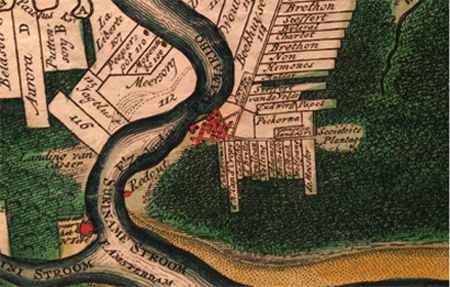Candatie Braskamp was born in 1802 and registered at plantation Dordrecht in 1851, together with her three children.
In 1862 slavery was abolished in the Dutch colonies in the West Indies. At that occasion slave owners have registered information about their slaves because they received a financial compensation for the loss of labour. This information (and other data related to slaves in Suriname) has been brought together in a database by drs Okke ten Hove and Heinrich Helstone. The database covers the period 1832-1863. It is available as Vrijverklaarde slaven (slaves that are declared as free) of the Dutch National Archives in The Hague. The database involves 34.442 individuals and includes the names of 6 Braskamps at the sugar plantation Dordrecht, on the right bank of the Suriname river, opposite Paramaribo. The six individuals arch three generations.
It remains to be seen why these persons were called Braskamp. According to an article by Prof.dr. Alex van Stipriaan Luiscius (former website) family names in 1863 were given by the authorities without input of the individuals concerned. In principle, no existing family names were used.
At Dordrecht also the names Brasdorp and Braswijk occurred and at other plantations Bras, Brashuis and Brasmans (also see surinameplantages.com), so it is likely that the names are just combinations of Bras and "village", "quarter", "house" or "person".
Information is also digitally available at Slavenregisters 1816-1863 (registers with slaves, 1816-1863). Though no family names are given, the information in this database can be linked to that in the other one. In the latter database the founder is called Candasie and not Candatie and furthermore Harry (1855) is not mentioned, but Henrij (1858) is.
At the Nationaal Archief Suriname there is a Harrij Julius Braskamp as witness in the civil registry (Burgerlijke Stand) in 1892, but not in the census of 1921.

| generation VII | ||
| Candatie Clarijntje Braskamp | Plantation Dordrecht 1802 | |
| generation VIII | ||
| children of Candatie Clarijntje Braskamp | Hermanus Jolie Lambertus Henriette |
Plantation Dordrecht 1823 Plantation Dordrecht 1836 Plantation Dordrecht 1837 |
| generation IX | ||
| children of Henriette Braskamp | Fiander (Phiander) Harry Henrij |
Plantation Dordrecht 1-3-1854 Plantation Dordrecht 17-10-1855 Plantation Dordrecht 27-5-1858 |
Hermanus and Jolie Lambertus both were digger (in Dutch: "delver") on the sugar plantation and Henriette in 1862 was maid in the field (in Dutch: "veldmeid"). Henriette's children Fiander and Harry then were 9 and 8 years old, respectively, and their profession is registered as in the garden ("in de tuin") and playing ("spelend"). It may be that Harry and Henrij in fact are the same persons, as Harry's slave name as mentioned in 1862 also was Henry.
Their religion was given as EBG (Evangelische Broeder Gemeente, Hernhutters), the Moravian church.
On 12 December 1892 Harrij Julius Braskamp, age 33, was witness at the registration in district Paramaribo of the birth of Rudolphina Geertruida Wilhelmina Eltenberg.
Harrij Julius seems born around 1859, so a bit later than the youngest of Henriette in the overview.
Plantage Dordrecht ging pas zo heten ca 1745 toen de grond van 1000 akkers in twee stukken werd verkocht. Het deel dat Dordrecht ging heten werd gekocht door Pieter van der Werff.
Het andere deel werd later Lust en Rust. Van der Werff was afkomstig uit Dordrecht en was samen met zijn broer Jacob en twee zusters naar Suriname gekomen. De grond werd in 1735 uitgegeven aan Willem Gerard van Meel, Raad-fiscaal in Suriname en later griffier bij het Hof van Justitie in Paramaribo. (bron: wikipedia).

Nummer 116 omvat het latere Dordrecht. Dit plaatje is een detail van een kaart die ten tijde van de Surinametentoonstelling (2019-2020) in Museum Van Loon aan de Keizersgracht in Amsterdam hing (Alexander de Lavaux Algemene kaart van Suriname 1737). Zie Rijksmuseum.